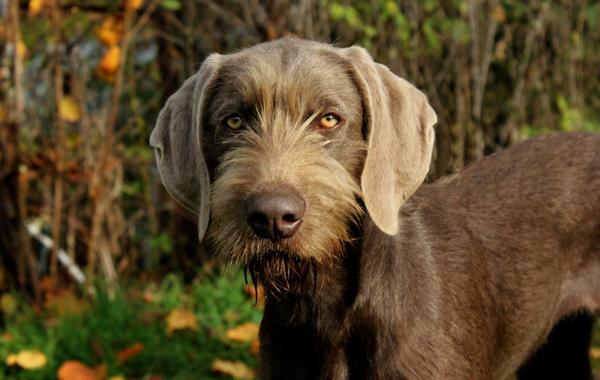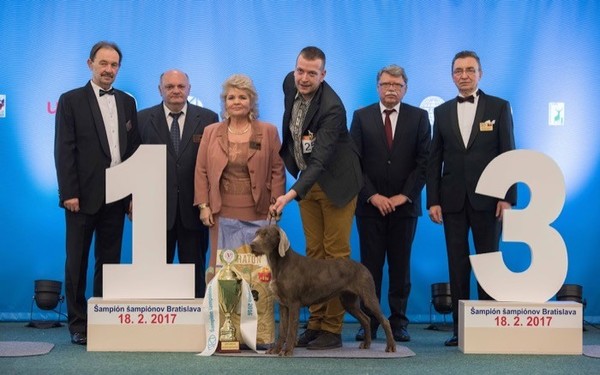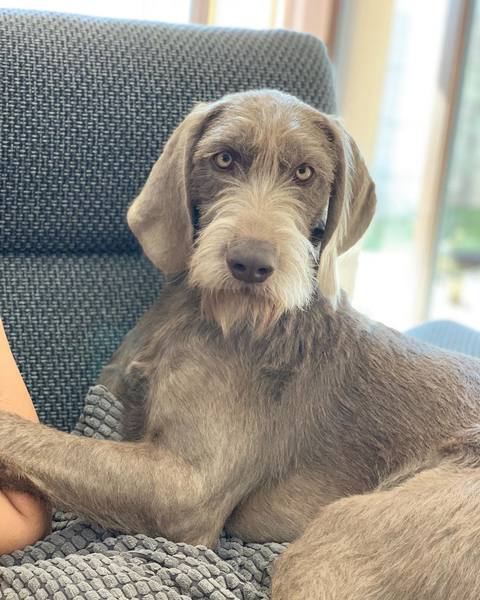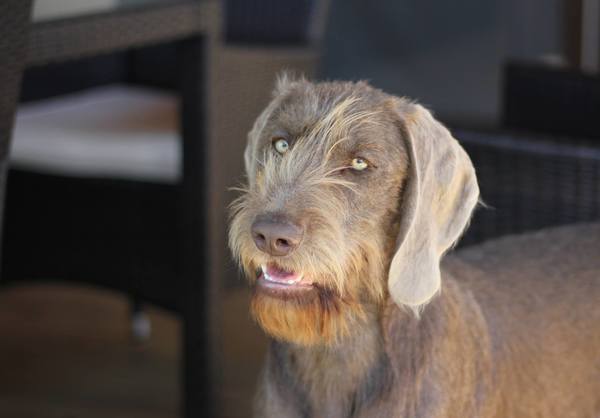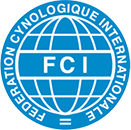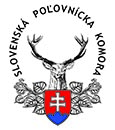Slovak rough haired Pointer
F.C.I. Standard No 320 / 01. 06. 2003 / GB
Origin: Slovakia
Utilization: Pointer
FCI Classification: Group 7 Pointing dogs; Section 1.1 Continental pointing dogs, type “Braque”; With working trial.
Brief historical summary:
The Slovak rough-haired pointer is a breed that originated in interbreeding. The foundation is the Weimaraner, from which the Slovak rough-haired pointer takes its colour and basic character traits. By crossing the Weimaraner with wire-haired breeds, in particular the Bohemian wire-haired pointing griffon (Český fousek) a breed was created of colour and traits similar to those of the Weimaraner, but with a rough coat. Until 1973, such dogs were entered into the Slovak Stud Book under the breed name Rough-haired Weimaraner. From 1973 onwards, they have been registered as an independent breed.
General appearance:
Dog of moderate strength, working type, but withnobleness in its lines. The basic colour of the coat is called “grey” and thehair is harsh (hard). He must be fit and able to work on the plain, in thewoods and in the water and especially to work after shooting, searchingand retrieving wounded game. He is obedient and easy to train.
The height at the withers: from 62 to 68 cm for the males and from 57 to64 cm for the females.
Shape: The ratio of the length of the body to the height at the withers must be of 10: 9 in the males and of 10 : 8 in the females.
Unique type: It is diserable that the dog be solidly built, but not of a heavy type.
Head
General description: Sufficiently long, lean, without folds in the skin, proportional to the body.
Skull: Rectangular shape, the superciliary arches must be pronounced, the frontal furrow visible. The occipital crest is felt at the touch.
Stop: The slope is moderate (about 45°).
Muzzle: Approximately the same length as the skull, sufficiently high and wide. Lower jaw even strong with a well developed set of teeth. The muzzle is straight.
Nose: Sufficiently large, dark in colour. Large nostrils.
Lips: Moderately developed, fitting closely, dark in colour.
Teeth: Well developed, scissor bite.
Eyes: Almond shape, well set into eyesocket, of amber colour, with an inteligent expression. In the puppies and the young dogs they are bluish (azure). The eyelids are dark.
Leathers: Of proportional length, set above eye level. Broad at the inset (base) and the flap is rounded.
Neck: Of medium length, lean, without skin folds, well muscled, inserted in the withers.
Body
General appearance, topline: The dog is well built, rather high in size, straight back, the neck attached high and the head carried high.
The wither: Well pronounced and well linked with the line of the back.
The back: Straight, well muscled, solid, very slightly sloping towards the rear. The croup is broad, sufficiently long, neither overbuilt nor drooping.
Chest: Sufficiently long and broad, oval, in proportion with the whole of the body, let down to the elbow. Ribs well sprung, breast well developed.
Belly and flanks: Moderately tucked in.
Tail: Moderately strong, set rather high, carried downwards when the dog is at rest; carried horizontally when the dog is in action. Well furnished with hair but not brush style. The tail is shortened (docked) at half length.
Forequarters: On the whole well developed, vertical seen from the front or in profile.
Scapula-humeral angle: 110°.
Angle of elbow: 135°.
Shoulder: Well developed and muscled.
Shoulder-blades: Placed obliquely.
Forearm: Vertical with lean and marked musculature.
Carpus: Practically vertical.
Pastern: Quite strong, relatively short, almost vertical.
Feet: Rounded with tight and well arched toes. The nails and the pads aredark in colour. Claws of inner toes must be removed.
Hindquarters: Well angulated ensemble seen from profile, and vertical seen from behind.
Thighs: Sufficiently long, broad and well muscled.
Angle of the hip, (coxal-femoral): 80°to 85°.
Leg: Broad, sufficiently long and well muscled.
Femoral-tibial (stifle) angle: Between 125°and 135°.
Hock: Almost vertical.
Feet: Rounded, toes tight and well arched. The nails and the pads are dark in colour. Dewclaws must be removed.
Gait/movement: Balanced, lively; at work on the plain the dog gallops.
Skin: Of medium thickness, elastic, without folds, of a grey colour.
Hair (coat):
Undercoat: Down short and fine. Normally looses it in the summer. Topcoat about 4 cm long, harsh, straight and flat. At the lower part of the muzzle, the hair is longer and softer, forming a moustache. Above the eyes, the hair is more marked and laying obliquely. The forehead and the occiput are covered with short harsh hair. The hair on the leathers is short and soft.
The tail is very hairy
Colour:
The basic colour is brown shaded sable (said “grey”) with varying lighter and darker shadings without white markings, or with white markings on the legs, and on the chest. Also “grey” with more or less large markings, or speckled.
Faults :
Any departure from the forgoing points should be considered a fault and the seriousness with which the fault should be regarded in exact proportion to its degree.
Serious faults:
• Size too big or too small in relation to the standard.
• Colour much too light going nearly white.
• Heavy appearance and without nobleness.
• Head too strong.
• Arched back.
• Leathers too long or too thick.
• Hair too short, without moustache.
Eliminatory faults:
• Other basic colour than the “grey” (brown shaded sable).
• All anatomical faults like prognathism upper or lower,
• entropion,
• ectropion,
• irregular position of the legs.
N.B.:
Male animals should have two apparently normal testicles fully descended into scrotum.
Standard in language: English, Francais, Deutsch, Espanol - http://www.fci.be/en/nomenclature/WIREHAIRED-SLOVAKIAN-POINTER-320.html
Original FCI standard in English
http://www.fci.be/Nomenclature/Standards/320g07-en.pdf
Internationale: Slovenský Hrubosrsty Stavač, Slovenský hrubosrstý ohař, Wirehaired Slovakian Pointer, Slovakian rough haired pointer, Slovakian wire haired pointer, Braque slovaque a poil dur, Slowakischer Rauhbart, Braco eslovaco de pelo duro

